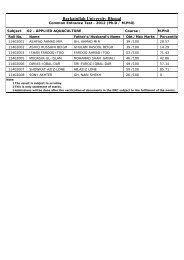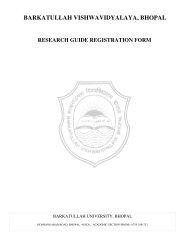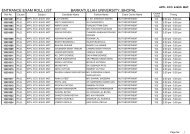O - Barkatullah University, Bhopal
O - Barkatullah University, Bhopal
O - Barkatullah University, Bhopal
You also want an ePaper? Increase the reach of your titles
YUMPU automatically turns print PDFs into web optimized ePapers that Google loves.
cjdrmYyk fo'ofo|ky;]Hkksiky<strong>Barkatullah</strong> <strong>University</strong>, <strong>Bhopal</strong>ih,p-MhMh- izos’k ijh{kk gsrq IkkB~;ØeSyllabus of Ph.D. Entrance Examination(Other Faculty)Management, Law, Home Science, Commerce,Education, Yogic Science, Physical Edu.Session 2012-132012&13izdk’kddqylfpocjdrmYyk fo’ofo|ky;]HkksikyPage 1 of 48
INDEX1. FACULTY – MANAGEMENTSl.No. SUBJECT Page No.1. Management 03-042. FACULTY – LAWSl.No. SUBJECT Page No.1. Law 05-123. FACULTY – HOME SCIENCESl.No. SUBJECT Page No.1. Home Science 13-144. FACULTY – COMMERCESl.No. SUBJECT Page No.1. Commerce 15-315. FACULTY – EDUCATIONSl.No. SUBJECT Page No.1. Education 32-412. Yogic Science 42-446. FACULTY – PHYSICAL EDUCATIONSl.No. SUBJECT Page No.1. Physical Education 45-48Page 2 of 48
BARKATULLAH UNIVERSITY, BHOPALSYLLABUS FOR ENTRANCE TEST FOR PH.D. INMANAGEMENTSUBJECT : MANAGEMENTMax. Marks : 100Note : There will be 100 objective type of questions Minimum Passing Marks will be40. No negative marking.1. Fundamentals of Management:-Management- Overview, Functions, Nature and Significance; Evolution ofManagement Thought – Taylor, Fayol, Elton Mayo, FC Bernard, Likert andWebber (Theories of Management); Recent Trends and Future Challenges ofManagement. Planning – Concept, Importance, Types and Process.Strategic Management – Overview and Process; MBO, Organizing -Principles, Structure, Process, Importance. Directing and Controlling –Motivation, Morale and Productivity, Leadership, Communication.2. Marketing Management:-Nature and scope of Marketing, The Marketing Environment andEnvironment Scanning. Marketing information system and Marketingresearch, Understanding Consumer and Industrial markets, Marketsegmentation, Targeting and positioning.Product decisions,Product mix, product life cycles, new productdevelopment, branding and packaging decisions, Pricing Methods andstrategies. Channel management-selection. New issues in marketing-Globalization, Consumerism, Green Marketing, Legal issues.3. Financial Management:-Aims and Objectives of Financial Management; Financial Analysis andControl. Investment and Capital Structure Decisions, Instruments of LongTerm Finance. Optimum Capital Structure. Basics Concept of – BudgetPage 3 of 48
Budgetary Control. Methods of Capital Budgeting. Management of WorkingCapital. Dividend Policy.4. Human Resource Management:-Concepts and Perspectives on Human Resource Management; HumanResource Management in a changing Environment; Human ResourcePlanning. Career and Succession Planning; Job Analysis and Job Description.Induction; Manpower Training and Development. Performance Appraisal; JobEvaluation & Wage Determination, Employee Welfare; Industrial Relations& Trade Unions; Dispute Resolution & Grievance Management.5. Business Policy, Strategic Management & ProductionManagement:Business Policy as a field of Study: General Management Point of View;Vision; Mission, Objectives and Policies, SWOT Analysis; Tools andTechniques for Strategic Analysis; Impact Matrix; Industry Analysis; Conceptof Value Chain; Framework for Analysing Competition Advantage of a firm.Nature and Scope of Production Location; Types of Manufacturing Systems& Layouts; Material Handling – Principles Production Planning and Control.Capacity Planning – Models; Process Planning, Aggregate PlanningScheduling, An Overview of Material Management, Material Planning andInventory Control. Industrial Safety; Total Quality Management.Page 4 of 48
BARKATULLAH UNIVERSITY, BHOPALSYLLABUS OF Ph.D. ENTRANCE EXAM- 2012SUBJECT : LAWPAPER (objective type)Maximum Marks: 100No. of Question: 100Question to be attempt 100Mini Marks : 40Note :-There will be 100 objective type of questions Minimum PassingMarks will be 40. No negative marking.The question will be asked on the following subjects:01 LAW AND SOCIAL TRANSFORMATION IN INDIA.02 INDIAN CONSTITUTIONAL LAW: THE NEW CHALLENGES.03 JUDICIAL PROCESS.04 LEGAL EDUCATION AND RESEARCH METHODOLOGY.Note:1. There will be no negative marking2. Each question will have four options3. The Candidate will require to darken completely thecorrect option in OMR Answer sheet.Page 5 of 48
BARKATULLAH UNIVERSITY, BHOPALSYLLABUS FOR Ph.D. ENTRANCE TEST- 2012SUBJECT : LAW(COMPULSORY COURSES OF LL.M)01 LAW AND SOCIAL TRANSFORMATION IN INDIA.Objectives of the courseThis course is designed to offer the teacher and the taught with –(a) Awareness of Indian approaches to social and economic problems in thecontext of law as a means of social control and change; And(b) a spirit of inquiry to explore and exploit law and legal institutions as ameans to achieve development within the framework of law. The endeavour isto make the students aware of therole the law has played and has to play in the contemporary Indian societyThe following syllabus prepared with this perspective will be spread over aperiod of one semesterSyllabus1. Law and social change1.1. Law as an instrument of social change.1.2. Law as the product of traditions and culture. Criticism and evaluation inthe light of colonization and the introduction of common law system andinstitutions in India and its impact on further development of law and legalinstitutions in India.2. Religion and the law2.1. Religion as a divisive factor.2.2. Secularism as a solution to the problem.2.3. Reform of the law on secular lines: Problems.2.4. Freedom of religion and non-discrimination on the basis of religion.2.5. Religious minorities and the law.3. Language and the law3.1. Language as a divisive factor: formation of linguistic states.3.2. Constitutional guarantees to linguistic minorities.3.3. Language policy and the Constitution: Official language; multi-languagesystem.3.4. Non-discrimination on the ground of language.4. Community and the law4.1. Caste as a divisive factor4.2. Non-discrimination on the ground of caste.4.3. Acceptance of caste as a factor to undo past injustices.Page 6 of 48
4.4. Protective discrimination: Scheduled castes, tribes and backward classes.4.5. Reservation; Statutory Commissions., Statutory provisions.5. Regionalism and the law5.1. Regionalism as a divisive factor.5.2. Concept of India as one unit.5.3. Right of movement, residence and business; impermissibility of state orregional barriers.5.4. Equality in matters of employment: the slogan "Sons of the soil" and itspractice.5.5. Admission to educational institutions: preference to residents of a state.6. Women and the law6.1. Crimes against women.6.2. Gender injustice and its various forms.6.3. Women's Commission.6.4. Empowerment of women: Constitutional and other legal provisions7. Children and the law7.1. Child labour.7.2. Sexual exploitation.7.3. Adoption and related problems.7.4. Children and education.8. Modernisation and the law8.1. Modernisation as a value: Constitutional perspectives reflected in thefundamental duties.8.2. Modernisation of social institutions through law.8.2.1. Reform of family law8.2.2. Agrarian reform - Industrialisation of agriculture.8.2.3. Industrial reform: Free enterprise v. State regulation - Industrialisation v.Environmental protection.8.3. Reform of court processes.8.3.1. Criminal law: Plea bargaining; compounding and payment ofcompensation tovictims.8.3.2. Civil law: (ADR) Confrontation v. consensus; mediation andconciliation; Lok adalats.8.3.3. Prison reforms.8.4. Democratic decentralisation and local self-government.9. Alternative approaches to law9.1. The jurisprudence of Sarvodaya- Gandhiji, Vinoba Bhave; JayaprakashNarayanPage 7 of 48
---Surrender of dacoits; concept of grama nyayalayas.9.2. Socialist thought on law and justice: An enquiry through constitutionaldebates onthe right to property.9.3. Indian Marxist critique of law and justice.9.4. Naxalite movement: causes and cure.002 INDIAN CONSTITUTIONAL LAW: THE NEW CHALLENGES.Objectives of the CourseThe Constitution, a living document, is said to be always in the making. Thejudicial process of constitutional interpretation involves a technique ofadapting the law to meet changing social mores.Constitution being the fundamental law, an insight into its new trends isessential for a meaningful understanding of the legal system and processes.The post graduate students in law who had the basic knowledge of IndianConstitutional Law at LL.B level, should be exposed to the new challengesand perspectives of constitutional development while they are allowed tochoose an area of law for specialisation. Obviously, rubrics under this paperrequire modification and updating from time to time.The following syllabus prepared with this perspective will be spread over aperiod of one semester.Syllabus1. Federalism1.1. Creation of new states1.2. Allocation and share of resources - distribution of grants in aid1.2.1. The inter-state disputes on resources1.3. Rehabilitation of internally displaced persons.1.4. Centre's responsibility and internal disturbance within States.1.5. Directions of the Centre to the State under Article 356 and 3651.6. Federal Comity : Relationship of trust and faith between Centre and State.1.7. Special status of certain States.1.7.1. Tribal Areas, Scheduled Areas2. "State" : Need for widening the definition in the wake of liberalisation.3. Right to equality: privatisation and its impact on affirmative action.4. Empowerment of women.5. Freedom of press and challenges of new scientific development5.1. Freedom of speech and right to broadcast and telecast.5.2. Right to strikes, hartal and bandh.6. Emerging regime of new rights and remedies6.1. Reading Directive Principles and Fundamental Duties into FundamentalRights 6.11. Compensation jurisprudencePage 8 of 48
6. 1.2. Right to education6.1.2.1. Commercialization of education and its impact.6.1.2.2. Brain drain by foreign education market.7. Right of minorities to establish and administer educational institutions andstate control.8. Secularism and religious fanaticism.9. Separation of powers: stresses and strain9.1. Judicial activism and judicial restraint.9.2. PIL: implementation.9.3. Judicial independence.9.3.1. Appointment, transfer and removal of judges.9.4. Accountability: executive and judiciary.9.5. Tribunals10. Democratic process10.1. Nexus of politics with criminals and the business.10.2. Election10.3. Election commission: status.10.4. Electoral Reforms10.5. Coalition government, 'stability, durability, corrupt practice'10.6. Grass root democracy.Select bibliography03 JUDICIAL PROCESSObjectives of the courseA lawyer, whether academic or professional, is expected to be competent toanalyse and evaluate the legal process from a broader juristic perspective.Hence a compulsory paper on JudicialProcess is essential in the LL.M curriculum. The objective of this paper is tostudy the nature of judicial process as an instrument of social ordering. It isintended to highlight the role of court as policy maker, participant in the powerprocess and as an instrument of social change. This paper further intends toexpose the intricacies of judicial creativity and the judicial tools andtechniquesEmployed in the process. Since the ultimate aim of any legal process or systemis pursuit of justice, a systematic study of the concept of justice and its varioustheoretical foundations is required. This paper, therefore, intends tofamiliarise the students with various theories, different aspects and alternativeways, of attaining justice.The following syllabus prepared with the above perspective will spread over aperiod of one semesterSyllabusPage 9 of 48
1. Nature of judicial process1.1. Judicial process as an instrument of social ordering1.2. Judicial process and creativity in law - common law model - LegalReasoning and growth of law - change and stability.1.3. The tools and techniques of judicial creativity and precedent.1.4. Legal development and creativity through legal reasoning under statutoryand codified systems.2. Special Dimensions of Judicial Process in Constitutional Adjudications.2.1. Notions of judicial review2.2. ' Role' in constitutional adjudication - various theories of judicial role.2.3. Tools and techniques in policy-making and creativity in constitutionaladjudication.2.4. Varieties of judicial and juristic activism2.5. Problems of accountability and judicial law-making.3. Judicial Process in India3.1. Indian debate on the role of judges and on the notion of judicial review.3.2. The "independence" of judiciary and the "political" nature of judicialprocess3.3. Judicial activism and creativity of the Supreme Court - the tools andtechniques ofcreativity.3.4. Judicial process in pursuit of constitutional goals and values - newdimensions of judicial activism and structural challenges3.5. Institutional liability of courts and judicial activism - scope and limits.4. The Concepts of Justice4.1. The concept of justice or Dharma in Indian thought4.2. Dharma as the foundation of legal ordering in Indian thought.4.3. The concept and various theories of justice in the western thought.4.4. Various theoretical bases of justice: the liberal contractual tradition, theliberal utilitarian tradition and the liberal moral tradition.5. Relation between Law and Justice5.1. Equivalence Theories - Justice as nothing more than the positive law ofthe stronger class5.2. Dependency theories - For its realisation justice depends on law, butjustice is not the same as law.5.3. The independence of justice theories - means to end relationship of lawand justice - The relationship in the context of the Indian constitutionalordering.5.4. Analysis of selected cases of the Supreme Court where the judicial processcan be seen as influenced by theories of justice.Page 10 of 48
004 LEGAL EDUCATION AND RESEARCH METHODOLOGYObjectives of the courseA post-graduate student of law should get an insight into the objectives oflegal education. He should have an exposure to programmes like organisationof seminars, publication of law journals and holding of legal aid clinics.Law is taught in different ways in different countries. The LL.M course, beingintended also to produce lawyers with better competence and expertise, it isimperative that the student should familiarise himself with the differentsystems of legal education. The lecture method both at LL.B level and LL.Mlevel has many demerits. The existing lacunae can be eliminated by followingothermethods of learning such as case methods, problem method, discussionmethod, seminar method and a combination of all these methods. The studenthas to be exposed to these methods so as to develop his skills.Growth of legal science in India depends on the nature and career of legalresearch. The syllabus is designed to develop also skills in research andwriting in a systematic manner.Syllabus1. Objectives of Legal Education2. Lecture Method of Teaching - Merits and demerits3. The Problem Method4. Discussion method and its suitability at postgraduate level teaching5. The Seminar Method of teaching6. Examination system and problems in evaluation - external and internalassessment.7. Student participation in law school programmes - Organisation of Seminars,publicationof journal and assessment of teachers8. Clinical legal education - legal aid, legal literacy, legal survey and lawreform9. Research Methods9.1. Socio Legal Research9.2. Doctrinal and non-doctrinal9.3. Relevance of empirical research9.4. Induction and deduction10. Identification of Problem of research10.1. What is a research problem?10.2. Survey of available literature and bibliographical research.Page 11 of 48
10.2.1. Legislative materials including subordinate legislation, notification andpolicy statements10.2.2. Decisional materials including foreign decisions; methods ofdiscovering the "rule of the case" tracing the history of important cases andensuring that these have not been over-ruled; discovering judicial conflict inthe area pertaining to the research Problem and the reasons thereof.10.2.3. Juristic writings - a survey of juristic literature relevant to selectproblems in India and foreign periodicals.10.2.4. Compilation of list of reports or special studies conducted relevant tothe problem.11. Preparation of the Research Design11.1. Formulation of the Research problem11.2. Devising tools and techniques for collection of data : Methodology11.2.1. Methods for the collection of statutory and case materials and juristicliterature11.2.2. Use of historical and comparative research materials11.2.3. Use of observation studies11.2.4. Use of questionnaires/interview11.2.5. Use of case studies11.2.6. Sampling procedures - design of sample, types of sampling to beadopted.11.2.7. Use of scaling techniques11.2.8. Jurimetrics11.3. Computerized Research - A study of legal research programmes such asLexis and West law coding11.4. Classification and tabulation of data - use of cards for data collection -Rules for tabulation. Explanation of tabulated data.11.5. Analysis of dataNo specific bibliography is suggested for this course since the coursematerials obviously depends upon the latest developments. Thesedevelopments in the areas specified in the course can be gathered from therecent materials such as case law, changes and amendments of laws,critical comments, studies and reports, articles and research papers andlastly contemporary emerging ethos impacting on constitutional valuesPage 12 of 48
BARKATULLAH UNIVERSITY, BHOPALDoctoral Entrance Test (DET)Subject : Home ScienceMax. Marks : 100Min. Marks : 40Note :-There will be 100 objective type of questions Minimum PassingMarks will be 40. No negative marking.I) Food & Nutrition.i) Micro & Micro nutrients :- Functions, Sauces, Requirements and Effect ofDeficiencies of carbohydrates, Proteins, Fats, Fat Salable Vitamins & Water solubleVitamins, Minerals.ii) Therapeutic Nutrition:- Basic concepts of Diet Therapy, Diet counseling, Role ofDietitian in Diet Counseling.iii) Community Nutrition:- Methods of Assessment of Nutritional status, assessment ofpatients need based on the patents data.iv) Food Preservation, food Adulteration, National & International agencies NIN,ICMR, ICAR,WHO, UNICEF.II) Human Development:-i) Principles of Child development, stages of growth and development, Child rearingpractices, Parent Child relationship.ii) Early childhood case & Education:- Behavioral problems Physically & mentallyretarded children ,Children with special needsiii) Counseling:- Techniques of counseling, Agencies working for welfare of women &children.III) Textile & clothing:-i) Dyeing, Printing & finishing of fibers yarns & fabrics.ii) Consumer and Textiles clothing.iii) Laundry- Methods of washing clothes- Hand washing, Machine washing, Drycleaning, Reagents used in laundry.iv) Modern Development in yarn, textured yarn technologyPage 13 of 48
IV) Resource Management:-i) Management of Resources- Time, Energy, Money.ii) Work simplification:- Importance & Techniques formal & Informal techniques.iii) Consumer education: Laws protecting consumer and consumer behavioriv) Landscaping ,Interior and exterior decorationIV) Extension Education:-i) Methods of Extension Education :- Individual contact method, group contact methodand mass contact method.ii) Extension and development programmes:- Integrated rural Developmentprogrammes (IRDP) Integrated child development services ( ICDS) Training ofRural youth for self Employment (TERYSEM) Development of women & Childrenin Rural Areas (DWCRA), National RURAL Health Mission (NRHM)iii) Communication:- Importance, process, media of communication MassCommunicationiv) Media systems ,Trends and techniques, AdvertisingPage 14 of 48
BARKATULLAH UNIVERSITY, BHOPAL, M.P.Ph.D./M.Phil. Entrance Test Syllabus for Commerce effective fromSession2012-2013Note : Ph.D./M.Phil. Entrance test syllabus for Applied Economics andBusiness Management Board and Commerce Board, under the faculty ofCommerce from the Session 2012-13Examination Scheme: Objective Type 100 Questions of One Marks Each.Passing marks is forty. No negative marks.Max Marks: 100 Min Marks: 40Note:1. Paper setter should cover the entire syllabus.2. There is no negative marking.Particulars101- Management ConceptsizcU/k dh vo/kkj.kk,a••Introduction: - Concepts of Management, Scope and Nature ofManagement, Approaches to management, Human Relation,Behavioral and System approach.ifjp; & izcU/k dh vo/kkj.kk] {ks= ,oa izca/k dh izd`fr] izcU/k dk n`f"Vdks.k]ekuoh; laca/k O;kogkfjd ,oa iz.kkyh n`f"Vdks.k APlanning: Concepts of Planning, Objectives and components ofplanning, Nature and Process of Planning, determination ofObjective. Management by Objectives, Management byException, Concepts, Nature and Process of decision-making.Theories of decision-making.fu;kstu & fu;kstu dh vo/kkj.kk] fu;kstu ds mnns'; ,oa ?kVd] fu;kstu dhizd`fr ,oa izfdz;k mnns';ksa dk fu/kkZj.k] mnns';ksa fufgr izca/k] viokn fufgr izca/k]fu.kZ;u dh vko/kkj.kk izd`fr ,oa izfdz;k] z;k] fu.kZ;u ds fl)kar APage 15 of 48
•••Organization: Concept, objectives and element of organization,process and principal of organization, Organization Structureand Charts, Span of Management, Delegation of Authority,Centralization and Decentralization.laxBu % laxBu dh vo/kkj.k] mnns'; ,oa rRo] laxBu ds izfdz;k ,oa fl)kar]laxBu lajpuk ,pa pkVZ] izca/k dk foLrkj vf/kdkjksa dk HkkjkiZ.k dsUnzh;dj.k ,oafodsUnzh;dj.k ADirection: Concept, Nature, Scope, Principles and Techniquesof Direction. Communication: Concepts, Process channel andMedia of Communication Barriers to effective communication,Building effective communication system.funsZ'ku % funsZ'ku dh vo/kkj.kk] izd`fr] {ks=] funsZ'ku ds fl)kar ,oa rduhdA lEizs"k.k dh ck/kk;sa] izHkkoh lEizs"k.k i)fr dk fuekZ.k AControl: Concept, Objectives, nature and process of control,levels and areas of control, Various control techniques. Z-Theory of Management. Management Education in India:Objectives, Present position and difficulties.fu;a=.k % fu;a=.k dh vo/kkj.kk] mnns';] izd`fr ,oa izfdz;kA fu;a=.k ds Lrj ,oa{ks=] fu;a=.k dh fofHkUu rduhd] izca/k dk tSM& fl)kar A Hkkjr esa izca/k f'k{kk %mnns'; orZeku fLFkfr ,oa dfBukb;ka ASuggested References:• T.N. Chabra – Principles & Practices of Management, Dhanpat Rai &Co.• L.M. Prasad – Management Process, Sultan chand New Delhi.• Koontz & Weihric – Essentials of Management, Tata McGraw Hill.• Rajesh Viswanathan, Principals & Management, Himaliy PublicityHouse.• MWk- lq/kk th & izca/k vo/kkj.kk o laxBukRed O;ogkj vkj-chch-MhMh- ifCyds'ku] t;iqj• 'kkg o rkarsM+ & izca/kdh; vo/kkj.kk• vxzoky vkj-lhlh- & izcaU/k vo/kkj.kk,a ,oa laxBukRed O;ogkj lkfgR; Hkou ifCyl'kZ]vkxjk• lDlsuk ,l-lhlh- & izcaU/k ds fl)kar & lkfgR; Hkou ifCyds'ku] vkxjk• 'kekZ ,oa lqjk.kk & izcU/k ds fl)kar ,oa O;ogkj & jes'k cqd fMiks] t;iqjPage 16 of 48
102- Business EnvironmentO;kolkf;d i;kZoj.kParticulars••Theoretical Framework of Business Environment: Concept,Significance and nature of business Environment: Elements ofenvironment – Internal and External, changing dimensions ofbusiness environment. Liberalization, privatization andGlobalization.O;olkf;d i;kZoj.k dh lS)kafrd lajpuk % O;kolkf;d i;kZoj.k] vo/kkj.kk] egRo,oa izd`frA i;kZoj.k ds rRo& vkUrfjd ,oa ckg;] O;olk; i;kZoj.k dsifjorZu'khy vk;ke mnkjhdj.k] j.k] futhdj.k ,oa oS'ohdj.k AEconomic Environment of Business: Significance and elementsof economic Environment, economic systems and businessenvironment, economic planning in India, GovernmentPolicies- Industrial policy, licensing policy, fiscal policy,monetary policy an EXIM Policy.O;olk; dk vkfFkZd i;kZoj.k % vkfFkZd i;kZoj.k dk egRo ,oa rRo] vkfFkZdiz.kkfy;ka ,oa O;olk; i;kZoj.k] Hkkjr esa vkfFkZd fu;kstuA ljdkjh uhfr;ka& vkS|ksfxd uhfr] vuqKki= uhfr] iz'kqYd uhfr] ekSfnzd uhfr ,oavk;kr&fu;kZr kZr ¼,fDte½ uhfr•Political and Legal Environment of Business : Monopoly andRestrictive Trade Practices (MRTP) Act, Foreign ExchangeManagement Act (FEMA), Consumer Protection Act, PatentLaws.O;olk; dk jktuSfrd ,oa oS/kkfud i;kZoj.k % ,dkf/kdkj ,oa izfrca/kkRed iO;kkikjO;ogkj vf/kfu;e ¼,e0vkj0Vh0ih0½ fons'kh fofue; izca/k vf/kfu;e ¼Qsek½]miHkksDrk laj{k.k vf/kfu;e] isVsaV dkuwuA•Socio, Cultural &International Environment: Socialresponsibility of business, Characteristics, Components,Scope, relationship between society and business, socio-culturalPage 17 of 48
•business Environment, Social Groups, World TradeOrganization (WTO), International Monetary Fund (IMF),Foreign Investment in India.lkekftd] lkaLd`frd ,oa vUrjkZ"Vªh; i;kZoj.k % O;olk; dk lkekftd nkf;Rolekt ,oa O;olk; ds y{k.k] rRo] {ks= ,oa nksuks ds laca/k A lkekftd &lkaLd`frd O;kolkf;d i;kZoj.k & lkekfte lewg] fo'o O;kikj laxBu¼MCyq0Vh0vks0½] vUrjkZ"Vªh; ekSfnzd dks"k ¼vkbZ0,e0,Q0½ Hkkjr esa fons'kh fofu;e ATechnological Environment: Concept, Online Channels, OnlineServices, Advantage of Online services, E-Commerce, Indianconditions of E-Commerce, Electronic Banking, FranchiseBusiness.rduhdh i;kZoj.k & vo/kkj.kk] vkWu ykbZu pSuYl vkWu ykbZu lsok;s] vkWuykbu lsokvksa ds ykHkA bysDVªkfud dkWelZ] Hkkjrh; n'kkvksa esa bysDVªkfudcSfdax] Qszapkbph O;olk;ASuggested References:• Adhikary, M: Economic Development of Business, Sultan Chand &sons, New delhi.• Cherunilam, Francis Environment Business Himalaya Publication,Bombay• Ghosh, Biswanath: Econimic environment of Business, VikasPublication New Delhi• tSu- ,o =sgu & O;kolkf;d okrkoj.k & oh-dsds- ifCyds'ku nfj;kxat ubZ fnYyh• tSu- MkW- ftusUnz dqekj & O;kolkf;d i;kZoj.k ¿e/; izns'k fgUnh xzUFk vdkneh] Hkksiky• mik/;k;] 'kekZ ,oa ih- n;ky & O;kolkf;d okrkoj.k & jes'k cqd fMiks t;iqj• ukSy[kk ,oa frokjh & O;kolkf;d fu;eu :ijs[kk & fot; cqd fMiks t;iqjPage 18 of 48
103- Advanced AccountingmPprj ys[kkaduParticulars• Advanced problems of Final Accountsvfaarae ys[ks ds mPprj iz'u••••Advanced Problems of Bank Reconciliation Statement,Rectification of Errors, Accounting for Non ProfitOrganization.cSad lek/kku fooj.k ds mUur iz'u] =qfV;ksa dk lq/kkj] xSj ykHk laxBuksa dkys[kkaduAccounting from Incomplete Records, Accounting forInsurance Claim.viw.kZ vfHkys[kksa ls ys[kkadu] chek nkoksa dk ys[kkaduInvestment A/c, Insolvency A/c.fofu;ksx [kkrs] fnokfy;k [kkrsDissolution of partnership firm including sales of firm anamalgamation.lk>snkjh QeZ dk fo?kVu] QeZ ds fodz; ,oa ,dhdj.k lfgrSuggested References:• Gupta R.L., Radhaswamy, M: Company Accounts: , Sultan Chand &sons, New delhi.• Shukla M C, Grewal T S And Gupta S P:Advanced Accounts: SultanChand & sons, New delhi.• Sehgal, Ashok & Deepak, Sehgal: Financial Accounting: TaxmannPublishers.• Banerjee, Financial Accounting : A Dynamic Approach PHI Learing.• prqosZnh lh-,y,y- ,Mokal ,dkmUVsUlh & Jh egkohj cqd fMiksa ifCy'klZ ubZ lMd fnYyh A• 'kqDy MkW- ,l-,l& foRrh; ys[kkadu & lkfgR; Hkou ifCy'kj] vkxjk• tSu- [k.Msoky ,oa ikjhd & mPprj ys[kkadu] jes'k cqd fMiksa] t;iqjPage 19 of 48
Particulars104- Cost Analysis And Controlykxr fo'ys"k.k ,oa fu;a=.kVarious cost concepts, Cost centre and cost unit, Methods and• techniques of Costing. Installation of costing system, Methods ofinventory control. Overheads Accounting.fofHkUu ykxr vo/kkj.kk,a] ykxr dsUnz ,oa bdkbZ ykxr] ykxr dh i)fr;ka ,oa rduhd] ykxri)fr dh LFkkiuk] lkexzh fu;a=.k dh fof/k;ka] mifjO;; ys[kkaduAProcess Accounting Joint product and Bye product, EquivalentProduction and Inter Process Profit, Operating Cost.• izfdz;k ys[kkadu] la;qDr mRikn ,oa miksRokn] leksRiknu ,oa var%izfd;k ykHk] ifjpkyu ykxrAMarginal Costing: Concepts, Break Even Analysis, Uniform Costing andInter firm comparison. Use of Managerial Costing in Business Decision.•lhekUr ykxr% vo/kkj.kk] lefoPNsn fo'ys"k.k] ,dhd`r ykxr] ,oa var%rqyuk]O;kolkf;d fu.kZ;u esa izca/kdh; ykxr dk iz;ksxBudgetary Control: Basic concepts, preparation of functionalBudget: Cost Audit : Objective and Advantages.•fu;kstu ctVjh fu;a=.k % ewy vo/kkj.kk;sa] kj.kk;sa] fdz;kaRekd ctV dh rS;kjh] ykxrvads{k.k % mnns'; ,oa ykHk AStandard Costing and Variance Analysis.•ekud ykxr ,oa fopj.k fo'ys"k.kSuggested References:• Arora, M N: Cost Accounting: Vikas Publication, New Delhi.• Aggarwal M L: Cost Accounting: Sahithya bhawan, Agra.• Jawaharlal: Cost Accounting : Tata McGraw Hills, New Delhi.• J. Medegowda : Advanced cost Accounting, Himalya Publishing,Bombay• Nigam & Jain, Cost Accounting Principle and preface PHI learning.• tSu- vxzoky ,oa xqIrk] ykxr fo'ys"k.k ,oa fu;a=.k & lkfgR; Hkou ifCyds'ku] vkxjk• vksloky] ekgs'ojh] eksnh xqIrk & mPprj ykxr ys[kkadu & jes'k cqd fMiks t;iqj• ukjax] feRry & ykxr ys[kkadu & dY;k.kh ifCy'klZ ubZ fnYyh• ekgs'ojh ,oa feRry & ykxr ys[kkadu & egkojh izdk'ku] fnYyhPage 20 of 48
201- Corporate Legal Frameworkfuxeh; fof/kd lajpukParticulars•••The Companies Act, 1956 (Relevant Provisions) : Definition,Types of companies, Memorandum of association, Articles ofassociation, Prospectus, Share capital and Membership,Meetings and Resolutions, Company Management,Managerial Remuneration, Winding up and dissolution ofcompanies.Hkkjrh; dEiuh vf/kfu;e 1956 ¼lacf/kar izko/kku½ % ifjHkk"kk] dEifu;ksa ds izdkj]ik"kZn lhek fu;e] ik"kZn vUrZfu;e] izfooj.k] va'k iwath ,oa lnL;rk] lHkk,a ,oaizLrko] dEiuh h izca/k] izca/kdh; ikfjJfed] dEifu;ksa dk ifjlekiu ,oa fo?kVuAThe Negotiable Instruments Act, 1881 : Definitions, Types ofNegotiable instruments, Negotiation Holder and holder in duecourse, Payment in due course; Endorsement and Crossing ofcheque; Presentation of negotiable instruments.ijkdzkE; foys[k vf/kfu;e] 1881 & ifjHkk"kk] ijkdzkE; foys[kksa ds izdkj]ijkdzkE; /kkjd vkSj ;Fkkfof/k/kkjd] ;Fkkfof/k Hkqxrku % psd dk js[kkadu ,oai`"Bkadu] ijdzkE; foys[kksa dk izLrqrhdj.k AMRTP Act 1969 : Monopolistic trade practices; Restrictivetrade Practices; Unfair trade practices.,dkf/kdkj izfrca/kkRed O;kikj O;ogkj vf/kfu;e 1969% ,dkf/kdkjkRed O;kikj]izfrca/kkRed O;kikj O;ogkj] vuqfpr O;kikj O;ogkjA••The Consumer Protection Act, 1986 : salient features;Definition of Consumer, Right of consumer; GrievanceRedressal Machinery.miHkksDrk laj{k.k vf/kfu;e] 1986 % fof'k"V y{k.k] miHkksDrk dhifjHkk"kk] miHkksDrk ds vf/kdkj] f'kdk;r fuokj.k ra= ¼e'khujh½Regulatory Environment for International Business : FEMA,WTO; Regulatory Framework of WTO, basic principles andits character, WTO provisions relating to preferentialtreatment of developing countries; regional groupings,technical standard, anti-dumping duties and other Non TariffBarriers. Custom valuation and dispute settlement, TRIP andTRIMSvarjkZ"Vªh; O;kikj ds fy, i;kZoj.k fu;ked % fons'kh fofue; izca/k vf/kfu;e¼Qsek½Qsek½] ] fo'o O;kikj laxBu ¼W.T.O. ¼W.T.O.½ % fo'o O;kikj laxBu dh fu;ked lajpuk]Page 21 of 48
SSvk/kkjHkwr fl)kar vkSj blds y{k.k] fo'o O;kikj laxBu esa efodkl'khy ns'kksa ds fy,vf/kekU;rk laca/kh O;ogkj ds izko/kku] {ks=h; lewghdj.k] rduhdh izeki] HkaMkj.kizfrjks/kh izHkkj vkSj vU; xSj iz'kqYd laca/kh vojks/kA lhek 'kqYd ewY;kdau vkSjfooknks dk fuiVku] ckSf)d laink laca/kh O;kikj vf/kdkj] ¼TRIP¼TRIPSS½fof½fofu;ksx laca/khO;kikj O;ogkj ¼TRIMS¼TRIMS½Suggested References:• P.C. Tulsiyan Business law, Tata McGraw Hill, New Delhi.• N.D. Kapoor Elements of merchandise law : sultanchand, New Delhi.• Chawla & Garg & Sareen : Business law, Kalyani Publishers, Ludhiana.• Chandra & Book Business law PHI Learning.• ukSy[kk vkj-,y,y- fux;h; fof/k O;k[;k] jes'k cqd fMiks t;iqj• 'kqDy ,oa lgk; fuxfer fof/k O;oLFkk & lkfgR; Hkou ifCyds'ku] vkxjk• tSu ih-lhlh- m|ferk fodkl dSyk'k iqLrd lnu] Hkksiky• vxzoky ,oa dksBkjh & Hkkjrh; dEiuh vf/kfu;e & lkfgR; Hkou ifCyds'ku] vkxjkPage 22 of 48
202- Organizational BehaviorlaxBukRed O;ogkjParticulars•••••Organization: Concept, Types and Significance, organizationalGoal and its determinants, Organizational Behaviour:Concept, nature and Significance, Organizational Behaviourmodels.laxBu & vo/kkj.kk] izdkj o egRo] laxBukRed y{; ,oa mlds fu/kkZjd AlaxBukRed O;ogkj% vo/kkj.kk] izd`fr vkSj egRo] laxBukRed O;ogkj vfHkdYiAPersonality: Concept, Theories, determinants and Importance,Perception: Concept, process and Theories, learning: Concept,components, affecting factors and theoriesO;fDrRo % vo/kkj.kk fofHkUu fl)kar] fu/kkZjd ,oa egRoA n`f"Vdks.k% vo/kkj.kkizfdz;k ,oa fofHkUu fl)karA lh[kuk % vo/kkj.kk] rRo] izHkkfor djus okys ?kVd vkSjfl)kar AMotivation: Meaning, types and important elements, theoriesof motivation, Attitude and values: Concept, factors ,Significance and TheoriesvfHkizsj.k % vFkZ] izdkj] vkSj egRoiw.kZ rRo] vfHkizsj.k ds fofHkUu fl)karA ewY; ,oaO;ogkj % vo/kkj.kk] ?kVd] egRo vkSj fofHkUu l)karAInterpersonal behaviour: Nature, transactional analysis,concept of groups, theories of group formation, groupcohesiveness, power and authorityvaroS;fDrd O;ogkj % izd`fr] varZfdz;kaRd fo'ys"k.k] lewg dh vo/kkj.kk] lewgfuekZ.k ds fl)kar] leku lewg 'kfDr vkSj vf/kdkjAOrganizational Conflicts: Causes and suggestions, developingsound organizational climate, management of change, conceptand process of organizational climate.laxBukRed fojks/k % dkj.k vkSj lq>ko] LoLFk laxBukRed okrkoj.k dk fodkl]ifjorZu dk izca/k] laxBukRed fodkl dh vo/kkj.kk vkSj izfdz;k ASuggested References:Page 23 of 48
• Prasad, L M - Organizational behavior Vikash Publisher New Delhi• Sudha, G S - Organizational behavior – Ramesh Book Depo Jaipur• Sandeep, Sareen - Organizational behavior• Aswathappa A.K. – organizational behaviour Himalaya PublishingHouse, Mumbai.• Miner : Organization Behaviour Essantial Theroriges of processstructure – PHI Learning.• lq/kk th ,l- feJk ';kjs ,oa ik.Ms; & laxBukRed O;ogkj] jes'k cqd fMiks] ] t;iqj• tSu ih-lhlh- & laxBukRed O;ogkj] jes'k cqd fMiks t;iqjPage 24 of 48
203- Advanced Statistical AnalysismPprj lkaf[;dh; fo'ys"k.kParticulars•••••Theory of probability- Probability Distributions, Binomial,Poisson and Normal distributions.izkf;drk ds fl)kar & izkf;drk forj.k] f}in] ikW;lu ,oa lkekU; forj.k ATheory of sampling and testing SignificanceU;kn'kZ ds fl)kar vkSj lkFkZdrk dh tkapAnalysis of variance (Including one way and two wayclassifications), Chi-square test.fopj.k fo'ys.k ¼,dkaxh vkSj f}ekaxhZ foxhZdj.k ds lkFk½] dkbZ oxZ ijh{k.k AInterpolation and extrapolation, Association of attributes.vkUrjx.ku ,oa ckg~;x.ku] xq.k lacU/kRegression analysis, statistical Decision Tree: Decision underrisk and uncertainty, Decision tree analysis.izrhixeu fo'ys.k] lkaf[;dh; fu.kZ; fl)kar & tksf[ke vkSj vfuf'prrk dh fLFkfresa fu.kZ;] fu.kZ; o`{k fo'ys"k.k ASuggested References:• Gupta S P- Statistical Methods, Sultan Chand & sons, New delhi.• Gupta .B.N.- Advanced Statistical Analysis• Elhance D. N. - Advanced Statistical Analysis – Kitab Mahal, NewDelhi• Gupta S.C.- Fundamental of Statistics, Himaliya Publishing House.• 'kqDy ,l- ,e- lgk; ,l-ihih- & lkf[;dh; fo'ys"k.k &lkfgR; Hkou ifCyds'ku] vkxjk• jktiqjksfgr] ekgs'ojh] 'kekZ & O;kolkf;d lkaf[;dh & jes'k cqd fMiks ifCy'klZ] t;iqj• Ukkxj Mh-dsds- ,u & lkaf[;dh ds fl)kar & ehuk{kh izdk'ku esjB• vxzoky ,u-ih & ifjek.kkRed izfof/k;ka & jes'k cqd fMiks] t;iqj• xqIrk oh-,u,u- & lkf[;dh; fo'ys"k.k &lkfgR; Hkou ifCyds'ku] vkxjkPage 25 of 48
204- Functional managementdk;kZRed izcU/kParticularsFinancial Management: Concept, Nature and objectives,functions of financial Manager, Financial Planning: Nature,need and influencing factors, characteristics of a sound• financial plan.foRrh; izca/k % vo/kkj.kk] izd`fr ,oa mnns';] foRrh; izca/kd ds dk;Z] foRrh;fu;kstu & izd`fr vko';drk vkSj izHkkfor djus okys ?kVd] LoLFk foRrh; ;kstukds y{k.k ACapitalization: Concept and Theories, over and undercapitalization, Capital Structure, balanced Capital Structure,trading on equity, Leverage: Financial And Operating• leverage.iwathdj.k % vo/kkj.kk ,oa fofo/k fl)kar] vfr vkSj vYi iawthdj.k] iawth lajpuk]larqfyr iwath lajPkuk] lerk ij O;kikj] narhdj.k ¼yhojst½ % foRrh; ,oa ifjpkyulaca/kh narhdj.k ¼yhojst½Marketing Management: Concept, Nature and objectives,Scope of Marketing, functions of Marketing Management,Marketing Mix. Advertisement Management: Meaning,Objectives , Functions and Scope, Media of advertisement,Selecting and advertisement media, Essentials of a good• advertisement copy, Meaning of sales promotion, Importance ,limitations and methods of sales promotion.foi.ku izca/k % foi.ku dh vo/kkj.kk] izd`fr vkSj {ks=] foi.ku izca/k ds dk;Z] foi.kufeJ.k foKkiu izca/k & mnns';] dk;Z vkSj {ks=] foi.ku ds ek/;e] ,d foKkiuek/;e dk pquko] vPNh foKkiu izfr dh vko';drk,a] fodz; izorZu dk vFkZ]egRo] lhek,a vkSj fodz; izorZu dh fof/k;ka APersonnel management: Concept, Functions, Scope andImportance, Significance of Man-power Planning, sources ofrecruitment, Characteristics of a good recruitment policy,concept of Selection: Selection procedure, Importance of• employee training, Methods of training.dkfeZd izca/k dh vo/kkj.kk % vo/kkj.kk] dk;Z] {ks= vkSj egRo] ekuo 'kfDr fu;kstudk egRo] HkrhZ ds L=ksr] vPNh HkrhZ uhfr ds y{k.k A p;u dh vo/kkj.kk] p;uizfof/k] deZpkjh izf'k{k.k dk egRo] izf'k{k.k dh fof/k;ka APage 26 of 48
•Production Management: Concept, Functions, Scope andImportance. Types of production system, concept of productionplanning, objective elements and steps, procedure ofproduction control, process of new product development,Concept of product diversification, Standardization,Simplification and Specialization.mRiknu izca/k % vo/kkj.kk] egRo {ks=] vkSj dk;Z] mRiknu iz.kkyh ds izdkjA mRiknufu;kstu dh vo/kkj.kk] mnns'; rRo vkSj pj.k] mRiknu fu;a=.k izfof/k] uo mRiknfodkl izfdz;k] mRikn fofo/khdj.k] izekihdj.k] ljyhdj.k vkSj fof'k"Vhdj.k dhvo/kkj.kkASuggested References:• Putti, J.M. : Management Functional Approach.• Khanka, S.S. : Entrepreneurial development, S.Chand , New Delhi.• Motihar M : Functional Management.• tSu- MkW- ftusUnz dqekj & foi.ku izca/k] e/; izns'k fgUnh xzUFk vdkneh] HkksikyA• tSu- ts-dsds- & dk;kZRed izca/k] izrhd izdk'ku bykgkcknA• iksjoky ,oa lq/kkj & mRiknu izcU/k & jes'k cqd fMiks] t;iqj• ekeksfj;k ,oa n'kksjk & lsfooxhZ; izcU/k & lkfgR; Hkou ifCyds'ku] vkxjk• 'kekZ ,oa lqjkuk & lsfooxhZ; izcU/k & jes'k cqd fMiks] t;iqj• lDlsuk ,l-lhlh- & lsfooxhZ; izcU/k & lkfgR; Hkou ifCyds'ku] vkxjk• vxzoky ,oa vxzoky & foRrh; izca/k & jes'k cqd fMiks] t;iqj• xqIrk ,l-ihih- foRrh; izca/k & lkfgR; Hkou ifCyds'ku] vkxjk• Hknknk ch-,e,e- ,oa iksjoky & foi.ku izca/k & jes'k cqd fMiks] t;iqj• ukSy[kk vkj-,y,y- & foi.ku ds fl)kar & jes'k cqd fMiks] t;iqj• vxzoky ,oa dksBkjh & foi.ku ds fl)kar & lkfgR; Hkou ifCyds'ku] vkxjk• dqyJs"B MkW- vkj-,l,l- foRrh; izcaU/k & lkfgR; Hkou ifCyds'ku] vkxjkPage 27 of 48
301- Managerial EconomicsizcU/kdh; vFkZ'kkL=ParticularsMeaning of Managerial Economics: Nature and Scope of ManagerialEconomics, Managerial Economist: Role and Responsibilities,• fundamental economist concept, Profit maximization theory.izca/kdh; vFkZ'kkL= dk vk'k;% izca/kdh; vFkZ'kkL= dh izd`fr] {ks=] izca/kdh; vFkZ'kkL=h % Hkwfedk,oa mRrjnkf;Ro] vk/kkjHkwr vkfFkZd vo/kkj.kkA ykHk vf/kdrehdj.k fl)karDemand analysis: Elasticity of Demand, Introduction explanatory theoryof consumer choice, indifference approach, Revealed preference theory.•ekax fo'ys".k % ekax dh yksp& ifjp;kRed foospu A xzkgd ilUnxh dh fl)kar] mnklhurkfo'ys"k.k] vf/keku izdVhdj.k fl)karProduction Function: Law of variable proportions, Law of return to scale.• mRiknu Qyu % ifjorZu'khy vuqikr fu;e] iSekus ds izfrQy dk fu;eBusiness Cycles: Nature and Phases, Theories of Business Cycles.•O;kikj pdz % izd`fr ,oa pj.k] O;olk; pdz ds fl)karProfit Management: Measurement of profit, concept of risk and• uncertainty.ykHk izca/k % ykHk dk ekiu] tksf[ke ,oa vfuf'prrk dh vo/kkj.kkSuggested References:• Chopra, O.P- Managerial Economics, Tata McGraw Hills, Delhi.• Dwivedi D.N. - Managerial Economics, Vikas Publication, New Delhi.• Jhingam M.L., Staphen J.K. Managerial Economics, Varunda Pub. Pvt.Ltd. Delhi.• MOTE, Paul & Gupta : Managerial Economics : Concepts &Cases ,Tata McGraw Hill, New Delhi.• D.M. Mithani Manageral Economic Himaliya Publishing HouseBombay.• flag izks- vkj-,u,u-] ] 'kekZ MWk- ds-,u,u-]pkS/kjh lh-,e,e-] ] izca/kdh; vFkZ'kkL= & jes'k cqd fMiks]t;iqjA• MWk- 'kekZ ,oa MkW-dsds- dstjhoky] izca/kdh; vFkZ'kkL=] lkfgR; Hkou ifCyds'ku] vkxjkA• TkSu ftusUnz dqekj & O;kolkf;d vFkZ'kkL= e-izeiz- fgUnh xzUFk vdkneh] HkksikyA• flUgk ,oa ikBd & izcU/kdh; vFkZ'kkL= & lkfgR; Hkou ifCy'klZ ,oa fMfLVªhO;qVj] vkxjkPage 28 of 48
ZZ302- Tax Planning and Managementdj fu;kstu ,oa izcU/kParticularsConcept of Tax Planning: Concept, Nature and objectives, Scope of tax• planning.dj fu;kstu dh vo/kkj.kk & vFkZ] {ks=] egRo] dj fu;kstu ds mnns';] ,oa {ks=Areas of tax planning: Ownership aspect, Activity aspect & locationalAspect, nature of business & tax planning.•dj fu;kstu ds {ks= & LokfeRo igyw] fdz;k'khyrk igyw] LFkkuh;dj.k igyw] O;olk; dh izd`fr,oa dj fu;kstuTax planning & setting up new business: Deductions available to newindustrial undertakings, Amalgamation, Merger & tax planning. Specialtax provisions relating to free trade Zones, Infrastructure & backward• areasu;s O;olk; dh LFkkiuk ,oa dj fu;kstu & ubZ vkS|ksfxd bdkbZ;ksa dks izkIr NwVs] ,dhdj.k]lfo;;u ,oa dj fu;kstu fo'ks"k dj izko/kku eqDr O;kikj {ks= lajpukRed {ks= ,oa fiNMs {ks=lacU/kh dj izko/kku ATax planning &financial decisions: Capital Structure decisions, Dividend,• Inter-corporate Dividend, Bonus Shares.dj fu;kstu ,oa foRrh; fu.kZ;u % iwath lajpuk fu.kZ;] ykHkka'k] vUrZdEiuh ykHkka'k] cksul va'kTax Assessment: Introduction, difference between tax planning and taxmanagement, Return of income and assessment, Penalties & prosecutions,•Appeals & Revisions.dj fu/kkZj.k % ifjp;] dj fu;kstu ,oa dj izca/k es varj] dj izca/k ds {ks=] vk; dk fooj.k ,oadj fu/kkZj.k] vFkZn.M ,oa vfHk;ksx] vihy ,oa iqufoZZpkjASuggested References:• Mehrotra, S. & Goyal S.P. - Tax Planning and Management, SahityaBhawan Publication Agra.• Lakhotia - Tax Planning and Management• DATEY,V.S. – Tas Planning & Management.,• Corporate Tax Planning, Sangina Vinod, Taxman Publication NewDehli.• ldyspk Jhiky & fux;h; dj fu;kstu ,oa izcaU/k & lrh'k fizaVlZ ,oa ifCy'klZ bUnkSj• esgjks=k ,p-lhlh- & dj fu;kstu ,oa izcU/k & lkfgR; Hkou ifCyds'ku] vkxjk• 'kekZ ,oa 'kekZ & djk/kku ,oa dj vk;kstu &jes'k cqd fMiks] t;iqjPage 29 of 48
Particulars•303- Entrepreneurship Skill developmentm|ferk dkS'ky fodklEntrepreneur: Definition, emergence of Entrepreneurial classes:Theories of Entrepreneurship, Socio-economic environment andEntrepreneurm|eh & ifjHkk"kk] m|e oxZ dk mnHko] m|ferk ds fl)kar lkekftd & vkfFkZdifjos'k ,oa m|eh A••••Promotion of a venture: Opportunity analysis, externalenvironmental forces, economic, social, technological andcompetitive factors, establishment of a new unit.lkglh ¼m|eh½ ds fy, izorZu & volj fo'ys"k.k] ckg; i;kZoj.kh; 'kfDr;ka] vkfFkZd]lkekftd] rduhdh ,oa izfr;ksfxrkRed kRed dkjd] ,d ubZ bdkbZ bdh LFkkiuk AEntrepreneurial Behaviour: Innovation and Entrepreneurship,Entrepreneurial behavior, Social responsibility.m|eh O;ogkj % uokpkj ,oa m|ferk] m|eh O;ogkj\ lkekftd mRrjnkf;RoAEntrepreneurial development programme: Entrepreneurialdevelopment, Programme relevance and achievements, role ofgovernment in organizing such programmes.m|ferk fodkl dk;Zdze % m|ferk fodkl dk;Zdze dh izklafxdrk ,oa miyfC/k;ka budk;Zdzeksa ds vk;kstu esa ljdkj dh HkwfedkEntrepreneurship and industrial development: Planning andgrowth of industrial activities through industrial policies of thegovernment, role of industrial estates, role of central and statelevel promotional services.fØ;kvks dk fu;kstu ,oa fodkl] vkS|ksfxd ifj{ks=ks dh Hkwfedk dsUnz ,oa jkT; jLrjh;izksRlkgu lsok;sa ASuggested References:• Shukla M.B. - Entrepreneurship development• Khanka S.S. : Entrepreneurship Development.• Sudha G.S. : Fundamentals of Enterpreneurship.• tSu] MkW- ftusUnz dqekj] m|ferk&fodkl] e-izeiz- fgUnh xzUFk vdkneh] HkksikyAksikyA• lq/kk th-,l,l- & O;kolkf;d m|ferk & jes'k cqd fMiks t;iqj• tSu ,oa 'kekZ & m|ferk dkS'ky fodkl & jes'k cqd fMiks t;iqjPage 30 of 48
304- Accounting for Managerial DecisionsizcU/kdh; fu.kZ;u ds fy, ys[kkaduParticularsManagement Accounting: Meaning, Nature and importance. Difference ofManagement Accounting with Cost Accounting and Financial• Accounting.izca/kdh; ys[kkadu % vFkZ] izd`fr ,oa egRo] izcaU/kdh; ys[kkadu] ykxr ys[kkadu ,oa foRrh;ys[kkadu esa varjNature and limitations of Financial Statements: Need and objectives of• financial analysis.foRrh; fooj.kksa dh izd`fr ,oa lhek,as % foRrh; fo'ys"k.k dh vko';drk ,oa mnns'; AFund Flow Analysis & Cash Flow Analysis: ( Application of AS-3)•dks"k izokg fo'ys"k.k ,oa jksd izokg fo'ys"k.k ¼A.S.¼A.S.-3 dk iz;ksx½Capital Budgeting: Nature and characteristics of long term investmentdecisions, Method of ranking investment proposals•iwath ctVu % nh?kZdkyhu fuos'k fu.kZ;ksa dh izd`fr ,oa fo'ks"krk,a] fuos'k izLrkoksa dh Js.kh;u dhfof/k AManagement Reporting system: Types of Reports, Responsibility• Accounting.izca/k izfrosnu i)fr % izfrosnu ds izdkj] mRrjnkf;Ro ys[kkadu ASuggested References:• Agarwal & Agarwal – Accounting for Managers.• Shrinivasan &Murugan : Accounting for management, S. Chand , NewDelhi.• Khan & Jain : Management Accounting.• Sharma & Gupta : Management Accounting, Kalyani Publishers,Ludiana.• Bhatiya Ruchi, Accounting for Managers, Himaliya Publisher house,Mumbai0• vxzoky oh-ihih- esgrk oh-dsds- & izcU/kdh; fu.kZ;ksa gsrq ys[kkadu & lkfgR; Hkou ifCy'klZ i,oaf fMLVªhC;qVj izk0fy0 vkxjk• xqIrk ,l-ihih- & izcU/kdh; ys[kakdu & lkfgR; Hkou ifCy'klZ ,oaf fMLVªhC;qVj izk0fy0vkxjk• vxzoky ts-dsds- vxzoky vkj-dsds- ,oa 'kekZ & izcU/kdh; fu.kZ; ys[kkadu & jes'k cqd fMiks]t;iqjPage 31 of 48
BARKATULLAH UNIVERSITY, BHOPALEntrance Test For Doctor of Philosophy in Educationand Master of Philosophy in EducationSUBJECT : EDUCATIONEligibility - As per the revised ordinance No. 14 & 20 of <strong>University</strong>.Design of question paper and syllabus.The entrance test shall comprise multiple choice objective type question paperhaving 100 questions of one mark each. The questions will be from four basic papersof M.Ed./ M.A. Education to asses the fundamental knowledge of the candidate. Theduration of paper will be of three hours. Minimum passing will be 40. There will beno negative marking.Papers and Syllabus from which questions will be asked.Sl.Name of the PapersNo. of MarksNo.Questions1 Philosophical and Sociological Foundation of 25 25Education2 Psychological Foundation of Education 25 253 Educational Research & Statistics 25 254 Educational Technology 25 25Total 100 100Page 32 of 48
PAPER-IPHILOSOPHICAL & SOCIOLOGICAL FOUNDATION OFEDUCATION25Marks :OBJECTIVES :-1- To enable the students to understand the contribution of philosophy ofeducation.2- To acquaint the students with the different philosophical schools.3- To develop adequate familiarity with social structure, class and caste.4- To help students to make a critical analysis of philosophical and sociologicalfoundation of education.5- To help students to know impact of religion, culture and society on education.UNIT-IUNIT-IIUNIT-IIIUNIT-IVPhilosophy and Education.- Concept and nature of Philosophy.- Concept and nature of Education.- Relationship between education and philosophy.Dimension of Philosophy in Relation to Education.- Metaphysical problem and education related to nature, man andsociety.- Epistemology in relation to education.- Axiology in relation to education.Schools of Educational Thoughts and Thinkers.- Comparative study of idealism, naturalism and pragmatism inrelation to concept of knowledge and reality (aim, content andmethods of education).- Western educational thinkers Plato, Rousseau and John Dewey.- Indian educational thinkers Gandhi, Vivekananda and Tagore.Sociological Foundation of Education.- Concept and nature of sociology of education.- Meaning and nature of social change and constraints on socialchange in India.Page 33 of 48
UNIT-VIssues in Sociology of Education.- Education and Modernization.- Education and religion and culture.- Education and democracy.Suggested Reading :-1- Anand C.L., et. al., -Teacher and Education in Emerging India, NCERT, NewDelhi.2- Choube S.P.- Great Indian Educational Philosophies, Vinod Pustak Mandir,Dr., Rangey Raghaw Marg., Agra.3- Choube S.P.- Western Educational Philosophers, Vinod Pustak Mandir, Dr.Rangey Raghwa Marg., Agra.4- Choube S.P. and Akhilesh Choube -Philosophical and SociologicalFoundation of Education, Vinod Pustak Mandir, Dr. Rangey Raghaw Marg.,Agra.5- Mohanty Jagannath – Indian Education in Emerging Society, SterlingPublication, New Delhi.6- Swaroop N.R. and Saxena – Philosophical and Sociological Foundation ofEducation.7- Agrawal, J.C. (1999). Theory and Principles of Education, New Delhi : VikasPublishing House Pvt. Ltd.8- Brubacher, J.S. (1969). Modern Philosophies of Education. Bombay: Tata-Mcgraw Hill.9- pkScs lj;w izlkn ,oa pkScs vf[kys’k&Hkkjr gsrq f’k{kk n’kZu] fnYyh e;wj isijcSDlA10- ekFkqj ,l-,l-&f’k{kk ds nk’kZfud rFkk lkekftd vk/kkj] fouksn iqLrd efUnj]vkxjkA---x---Page 34 of 48
OBJECTIVES :-PAPER-IIPSYCHOLOGICAL FOUNDATION OF EDUCATION25Marks :1- To enable the students to understand psychology as a scientific discipline andits applications to Education.2- To enable the students to understand the nature of development and toappreciate the common characteristics, needs and behavioral problem ofchildren and adolescents at successive stages of development.3- To acquaint the students about the nature and concept of motivation andlearners.UNIT-IPsychology and Education.- Concept, Scope of educational psychology Western andIndianviews.- Relevance of educational psychology to learners, teachers andteaching learning process.- Methods of studying behaviour of learners (observationexperimental and case study).UNIT-IIGrowth and Development.- Principles and stages of growth, development and maturation.- Factors affecting growth and development.- Socio-Emotional development ( Erickson)- Moral development (Piaget and Kohlberg )UNIT-IIICognition, Intelligence and Creativity.- Cognitive development- Piaget theory and its educationalimplication.- Intelligence- Meaning, theories with reference to multipleintelligences.- SI Model/ (Guilford) emotional intelligence (Goleman)and their educational implication.- Measurement of intelligence.- Creativity- Concept, Stages, identification, fostering withspecial reference to Guilford and Torrance.Page 35 of 48
UNIT-IVUNIT-VMotivation and Learning.- Significance and concept of motivation in education.- Theories of motivation with special reference to selfactualization (Maslow) and achievement motivation (Atkinson).- Learning theories behaviorist (Pavlov and Skinner), Learning byinsight (Hull and Tollman).Personality Development.- Personality: concept, factors affecting development. Westernand Indigenous views.- Theories of personality with special reference to traitapproach, type, theories and psycho-analytic theory and theireducational implication.- Assessment of personality : objective, subjective, projective andpsychometric.Suggested Reading :-1- Bhatia, H.R.–Elements of Educational Psychology, Orient Langman Ltd.Bombay.2- Chouhan, S.S.- Advance Educational Psychology, Vikas Publishing House,New Delhi.3- Chouhan S.S.- Psychology and Adolescence, Allied Publisher, New Delhi.4- Gulati Sushma- Education for Creativity, NCERT, 1995.5- Hurlock E.B.- Adolescent Development, Mc. Graw Hill, New York.6- James O. Whittaker- Introduction to Psychology, W.B. Saunders Comp.,Tronoto.7- Kulshreshtha S.P.- Educational Psychology.8- Mangal S.K.- Psychological Education, Prakash Brother.9- Mathur S.S.- Shiksha Manovigyan, Lyall Book Depot, Meerut .10- Srivastava G.N.P.- Recent Trends in Educational Psychology, Psycho, Cell,Agra.11- Tripathi S.N.- Prathiba Aur Srijantma Mcmillan Co., Bombay.12- Singh Y.K. & Ruchika Nath- Teaching of Psychology.13- Singh Y.K. & Ruchika Nath- Psychology in Education.14- Whittaker- Introduction to Psycho.---x---Page 36 of 48
PAPER-IIIEDUCATIONAL RESEARCH AND STATISTICSMarks :25OBJECTIVES:-To enable the students to:-1- understand the meaning of scientific method, scientific inquiry, paradigm,theory and their implication for educational research.2- understand the characteristics of philosophical, psychological and sociologicalresearches in education.3- develop the ability and competence of students to plan and execute researchand apply its findings in educational practices.4- understand the methodology of various type of researches.5- understand the type of analysis and interpretation.6- To acquaint students with statistical method and processor.UNIT-IUNIT-IIUNIT-IIIOverview of Educational Research.- Meaning, significance and scope of educational research.- Research process : quantitative, qualitative and steps inresearch.- Areas and sources of educational research.Types of Educational Research.- Basic/ fundamental applied & action research.- Approaches of educational research.- Types of research : Descriptive, Historical, Survey,Ethnographical.Research Problem and Research Report.- Identification of problem, source of identification, aims andobjectives of educational research.- Research proposal/ synopsis and format of research report.- Hypothesis, variables.Hypothesis, Sampling, Tool.- Hypothesis- Concept, difference with assumption, sources,varioustypes and formulation of hypothesis and testing of hypothesis.Page 37 of 48
usesUNIT-IVUNIT-V- Sample - Concept of sample, universe, population, types andtechniques.Tools-- Characteristics of good tool.- Types of research, research tool and techniques and their- Types of tool- Questionnaire, Interview, Observation, CaseStudy, attitude and Scale, Projective and socio-metrictechniques.- Data Collection.Research Design.- Research design : single, control and factorial research design,experimental design.- Qualitative design (case study, ethnography study.)- Quantitative design.Statistics in Education.- Measures of central tendency (Mean, Median, Mode).- Measures of variability (standard deviation).- Percentile- percentile ranks.- Test of significance (‘t’ test, chi-square).- Correlation- rank order, product movement.Suggested Reading :-1- Bhatnagar- Reading in Methodology of Research in Education.2- Carter V. Good- Methods in Research, Appleton Century Crafts, Inc. DouglasE. Scates.3- F.J. MC Guigan- Experimental Psychology (A Methodological Approach)Prentice Hall of India Pvt. Ltd., New Delhi4- Kothari C.R.- Research Methodology Methods and Techniques, Wileg.Eastern Ltd.5- Leon Festinger- Research Methods in the Behaviour Sciences. Daniel Latz.6- Mishra B.K. & Saxena N.R.- Fundamentals of Educational Research.7- Sharma R.A.- Essential of Measurement in Education and Psychology.8- dfiy ,p-ds-&vuqla/kku fof/k;kW ¼O;ogkjijd½ gj izlkn HkkxZo] vkxjkA9- HkkxZo egs’k] ykHk flag ,oa izlkn }kjdk&euksfoKku ,oa 'kSf{kd lkaf[;dh dsewy vk/kkjA10- JhokLro jketh & lkekftd foKkuksa esa lkaf[;dh fof/k;kW] eksrhykycukjlhnkl vklh; vkyeA---x---Page 38 of 48
PAPER-IVEDUCATIONAL TECHNOLOGYMarks : 25OBJECTIVES:-On completion of this course, the students will be able to :1- replicate the nature, scope and significance of educational technology in totalscheme of education2- apply the expertise gained in tackling the problems of Indian education.3- understand the systems approach to education and communication theoriesand modes of communication.4- describe various teaching strategies, models and theories of teaching.5- know the instructional design and modes of development of self learningmaterial.6- develop the ability for critical appraisal of the audio-visual media.7- develop basic skills in the production of different types of instructionalmaterial.8- know the recent innovations and future perspectives of education technology.UNIT-IUNIT-IINature and Scope.- Educational technology – concept, nature, scope andsignificance of educational technology. Application ofeducational technology in Indian classroom.- Forms of educational technology: teaching technology,instructional technology and behaviour technology.- Approaches of educational technology: hardware and software.- Major institutions of educational technology in India- CIET,EMMRC (AVRC, EMRC and MCRC), IGNOU, SIET,consortium for educational communication (CEC).Systems Approach to Education and Communication.- Systems approach to education and its components: Goalsetting, task analysis.- Content analysis, context analysis and evaluation strategies.- Effectiveness of communication in instructional system,concepts, process, principles, components, modes and barriersof communication. Basic model of communication- sendermessage-receiver.- Mass media, current status of mass media in education.Teacher’s role in using mass media.Page 39 of 48
- Personalised system of instruction, programmed instruction(linear and branching model), computer assisted instruction,brainstorming and auto tutorial instruction- their characteristics,advantages and limitations.UNIT-IIIInstructional Design, Strategies and Models of Teaching.- Instructional design: concept, views, process and stages ofdevelopment of instructional design.- 3 designing of instructional strategies, such as lecture teamteaching, discussion, panel discussion, seminars & tutorials.- Concept of teaching strategies- difference between teachingstrategies and teaching tactics. Classification of teachingstrategies.- Nature and use of teaching models. Types of teaching modelsinquirytraining model, aptitude treatment interaction model,behavioural model, their nature, characteristics, merits andlimitations.- Flander’s interaction analysis, simulation.UNIT-IVAudio Visual Media in Education.- Audio-Visual media- meaning, importance ad various forms.- Audio/Radio : Broadcast and audio recordings- strengths andlimitations criteria for selection of instructional units, scriptwriting, pre-production, post-production, process and practices,use of RCCP in teaching, role of AIR/Gyanvani, audioconferencing and interactive radio conference.- Video/educational television: Telecast and video recordingsstrengthsand limitations, use of television and CCTV ininstruction and training, teleconferencing, video conferencing,SITE experiment, countrywide class room project and satellitebased instructions, gyandarshan and SIET programmes.- Use of animation films for the development of children’simagination.- Technological aids-teaching machines, computers andlaboratories and audio-visual appliances-their nature,characteristics, advantages and limitations.Page 40 of 48
UNIT-VNew Horizons of Educational Technology.- Recent innovations in the area of ET interactive video-Hypertext, video- texts, optical fiber technology- laser disc,computer conferencing etc.- Procedure and organization of teleconferencing/interactivevideo- experiences of institutions, open schools and openuniversities.- Recent experiments in the third world countries and pointers forIndia with reference to education.- Recent trends of research in educational technology and itsfuture with reference to education.- Future priorities in educational technology.Suggested Reading :-1- Behera, S.C. (1991)- Educational Television Programmes, Deep and DeepPublications, New Delhi.2- Coburn, P. and et. Al (1985)- Practical Guide to Computers in Education,Addison- Wesley Publishing Company, Inc.3- Das, R.C. (1993)- Educational Technology- A Basic Text, Sterling PublishersPvt. Ltd.4- Evaut, M. The International Encyclopaedia of Educational Technology.5- Graeme, K. (1969)- Blackbard to computers: A Guide to Educational Aids,London, Ward Lock.6- Hass, K.B. and Packer, H.Q. (1990)- Preparation and Use of Audio VisualAids, 3 rd Editions, Prentice Hall, Inc.7- Kumar, K.L. (2008)_ Educational Technology, New Age International Pvt.Ltd. Publishers, New Delhi (Second Revised Edition).8- Mukhopadhyay, M. (1990)- Educational Technology- Callenging Issues,Sterling Publishers Pvt. Ltd., New Delhi.9- Sampath et. Al (1981)- Introduction to Educational Technology, SterlingPublishers Pvt. Ltd.10- Sharma. B.M. (1994)- Media and Education, New Delhi: Commonwealth.11- Venkataiah, N. (1996)- Educational Technology, New Delhi: APH PublishingCorporation.12- Ruhela S.P. (2001)- Some Aspects of Educational Technology.13- Sharma R.A. : Programmed Instruction- An Instructional Technology, LoyalBank Depot. Meerut (U.P.)14- Sharma R.A. : Programme Instruction- An Instructional Technology, GoyalBook Depot., Meerut.---x---Page 41 of 48
Note :(i)(ii)BARKATULLAH UNIVERSITY, BHOPALDepartment of Yogic ScienceSyllabus for Ph.D/M.Phil. Entrance TestSubject : Yogic ScienceMax. Marks : 100Min. Marks : 40Paper setter shall set 100 questions from the syllabus and each questionshall carry one mark.Number of questions should be set equally from each unit (ten questionsfrom each unit) of the prescribed syllabus.UNIT - I Fundamental of Yogic ScienceOrigin & definitions of yoga. Scope of yoga, Personality of a yogi - itscharacteristics. Nature of yoga in Upnishads, Gita, Yoga Vashistha,Saddarshan & Ayurveda. Types of yoga - Rajyoga, Bhakti Yoga,Jnan Yoga,Karma Yoga, Astangyoga. Life Sketch & their contributions in the field ofyoga Patanjali,Yajnavalkya, Gorakshnath, Swami Dayanand, SwamiVivekananda, Swami Kuvalayananda.UNIT - II Yoga SutraHistorical and compositional knowledge of Patanjal Yoga Sutras, Concept ofYoga; Chitta- its Bhumis and Vrittis, methods of Vritti control; Samadhiconceptand its types, God- its concept and need.Yogantrayas; Kriya Yoga,Principle of Karma, Astang Yoga, Panch Kleshas, Sanyama, Occult powers,Prakriti, Purusha & Kaivalya.UNIT - III Principles of HathyogaHathyoga- concept, definition, Proper place, time, season for Hathyogicpractices, elements of success and failure in Hath yoga, Sign & symptoms ofsuccess in Hath yoga, Scope of Hath yoga in modern times. Basicknowledge of Hath yoga texts. Knowledge of Asanas, Shatkarmas,Pranayama, Mudra & Bandha, Pratyahara, Meditation & Samadhi asdescribed in Hath pradipika & Gherand Samhita; Nadanusandhan,Page 42 of 48
Kundalini- its form & means of awakening, Nadis, Chakras & Koshas- theirbasic knowledge.UNIT - IV Samkhya & Geeta(A) Three types of miseries in accordance with Samkhya, means toovercoming them, origin of 25 elements,Satkaryavada, form of Gunas,Purusha, Prakriti. Eight major functions of Buddhi, Thirteen causativefactors,eight occult powers, liberation.(B) Geeta- Soul, Law of Karma, form of religion & Samnyas, means toachieve Braham-Jnan, Abhyasa & Vairagya, Meditation, Elusion & Conceptof God.UNIT - V Human Anatomy & Physiology(A) Basic knowledge of anatomical & physiological aspects of humanskeletal, muscular, digestive,respiratory, cardio-vascular, excretory,endocrinal, sense organs & nervous systems and the effects of yogicpractices on them.UNIT - VI Human ConsciousnessConsciousness- its meaning, concept, definition & its form. Need of study forHuman consciousness,Present problems and their means of eradication,Consciousness in Vedas, Upnishads, Philosophy,Tantra, Astrology &Ayurveda. Consciousness in Western world and principle of Quantam,Consciousness- its attitude in modern psychology, different mysteries ofConsciousness - birth & life & luck, purusarth,fruits of Karma, Sanskar &rebirth. Various methods of development of Human consciousness.UNIT - VII Yoga & HealthHealth- its concept & aims, Swasthvrat Vigyan- meaning & aims, Yoga &Ayurveda based daily regime, night regime, seasonal regime, Sadvrat andAchar Rasayan. Diet- its concept, definition, types, Balanced diet and itscomponents, quantity, timing, Rules & regulations of diet based uponHathyoga & Swara Yoga, Indicated and contraindicated dietary articles for ayoga practitioner.Page 43 of 48
UNIT - VIII NaturopathyNaturopathy- its concept, history & basic principles. Principles, technique &benefits of Mud therapy,water therapy, Air therapy, Diet therapy, Sun raystherapy, fasting therapy, Massage therapy.UNIT - IX Yogic & Alternative therapies(A) Concept of Health & disease, Principles of Yogic therapy causes, sign &symptoms and yogic treatment of skeletal, digestive, respiratory cardiovascular,endocrinal, nervous system & mental disorders, sense organsrelated problems.(B) Alternative therapy - its concept, aims & objectives, types- Acupressure,Pranic healing, Magneto therapy, Swarayogic therapy.UNIT - X Research MethodologyResearch – Concept , meaning and types ; LiteraryResearch - Methods and resources ; Empirical research – Research Design, hypothesis , sampling , mean, median, mode and standard deviation ;Variables – Dependent and Independent.Page 44 of 48
BARKATULLAH UNIVERSITY, BHOPALSyllabus for Ph D Entrance Exam 2012Subject – Physical EducationMax. Marks : 100Min. Marks : 40Note : There will be 100 objective type of questions. Minimum Passing Marks will be40. No negative marking.Page 45 of 48
Page 46 of 48
Page 47 of 48
Page 48 of 48



![cjdrmYyk fo'ofo|ky;] Hkksiky cjdrmYyk fo'ofo|ky - Barkatullah ...](https://img.yumpu.com/50831007/1/190x245/cjdrmyyk-foofo-ky-hkksiky-cjdrmyyk-foofo-ky-barkatullah-.jpg?quality=85)
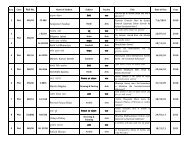
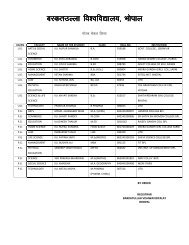
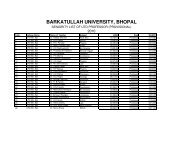

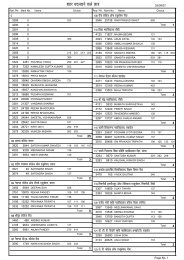
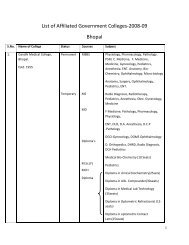
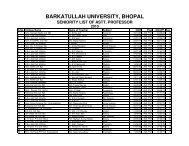
![cjdrmYyk fo'ofo|ky;] Hkksiky cjdrmYyk fo'ofo|ky;] Hkksiky - Barkatullah ...](https://img.yumpu.com/46923562/1/190x245/cjdrmyyk-foofo-ky-hkksiky-cjdrmyyk-foofo-ky-hkksiky-barkatullah-.jpg?quality=85)
